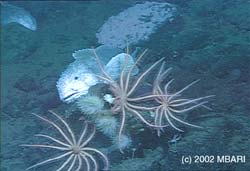
Exploring a deep-sea ridge off Northern California, scientists at the Monterey Bay Aquarium Research Institute (MBARI) have discovered a unique undersea nursery, where groups of fish and octopus brood their eggs, like chickens on their nests. This is the first time that marine biologists have directly observed any deep-sea fish brooding its eggs. It is also the first time that two different types of mobile deep-sea animals have been observed brooding together in the same area. Although the scientists
Widespread crime and the rise of global terrorism have meant that security systems need to incorporate sophisticated and rapid computer recognition of human faces, as delegates will hear next week at the British Machine Vision Conference being held at the University of East Anglia (UEA).
Another side of the same coin is in making human faces that appear on computers as convincing as possible, and in particular making speech appear realistic, as a team of UEA researchers will tell the confere
Identifying the structures of certain types of molecular compounds can now take minutes, instead of days, and be performed much more accurately, say scientists who developed a new approach for analyzing key experimental X-ray data.
Knowing the structure of a molecule allows scientists to predict its properties and behavior. While X-ray diffraction measurements have become a powerful tool for determining molecular structure, identifying the three-dimensional structure that best fits the diff
Smokers carrying a newly found genetic marker are 5-10 times more likely to fall victim to the disease than other smokers; 120 times more than nonsmokers who don’t carry the marker
Scientists at the Weizmann Institute have discovered a new genetic risk factor that increases the susceptibility of smokers to lung cancer.
Published in the Journal of the National Cancer Institute, the findings show that smokers who carry the newly discovered genetic marker are around 120 times
A new University of Colorado at Boulder study of Jupiter’s moon Europa may help explain the origin of the giant ice domes peppering its surface and the implications for discovering evidence of past or present life forms there.
Assistant Professor Robert Pappalardo and doctoral student Amy Barr previously believed the mysterious domes may be formed by blobs of ice from the interior of the frozen shell that were being pushed upward by thermal upwelling from warmer ice underneath. Europa
Seeing really is believing
“Virtual product demonstrations that allow individuals to interact with merchandise create more vivid mental images of the consumer using the products, thereby increasing the likelihood they’ll purchase the item,” said Ann Schlosser, UW Business School assistant professor of marketing.
“We’ve found that the more easily individuals can envision themselves using a product, the more likely they are to buy it.”
Schlosser studied how consumer